Content note: This blog post includes detailed descriptions of violence, execution and punishment.
In 1352 the crime of treason was defined for the first time in English law. But how were traitors punished in the pre-modern period? In this blog, I’m going to explore some of the more unusual, symbolic and grisly executions of traitors, but also the ways in which royal mercy could pardon traitors.
Hanged, drawn, and quartered
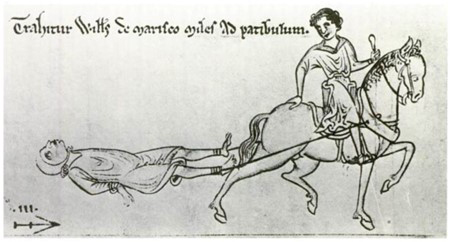
The main hallmark of the execution of traitors was for the individual to be drawn (dragged) to the place of their execution. The first known image of this comes from the 1242 execution of one William de Marisco, implicated in an attempt on Henry III’s life. The image shows him being dragged behind a horse to his execution.
A hurdle (similar to a sled) was later introduced in order to ensure the traitor did not die on the way. It was at the end of the century, however, with the trial and execution of Dafydd ap Gruffydd, when the symbolic – and almost ritual – execution of traitors would be used in the form familiar to us today: hanged, drawn, and quartered.
The severity of Dafydd ap Gruffydd’s punishment was almost certainly influenced by Edward I’s anger against the Welsh prince, who had rebelled against him, and each form of his execution was linked to specific crimes. For betraying the king he was to be drawn at the horse’s tail to the place of execution. For killing certain English noblemen, he was to be hanged alive. For committing murders during Easter, he was to be disembowelled (while still alive) and his entrails burned. For plotting the king’s death in different parts of the realm, he was to be quartered and the quarters despatched around the realm to act as deterrents. This was designed to be brutal, and a warning to all those who might consider rebellion against the king, particularly in those locations where the quarters were sent.
A similar symbolic form of execution would be seen in the execution of William Wallace a few decades later, setting a clear precedent for the future execution of traitors. It was not entirely fixed – disembowelling and castration were often, but not always included – but the process of drawing to the execution site, hanging the traitor until they were nearly dead, beheading and quartering were now fixed as the means of executing a male traitor (see footnote 1). Women were instead burned to death (a practice which would remain in law until 1790).

Many of the records in our collection contain details of the sentencing of traitors, often with the marginal annotation ‘T & S’ (referencing the Latin ‘Trahatur et Suspendatur’) recording that a traitor was sentenced to be drawn and hanged, including that of Edward, Earl of Warwick .
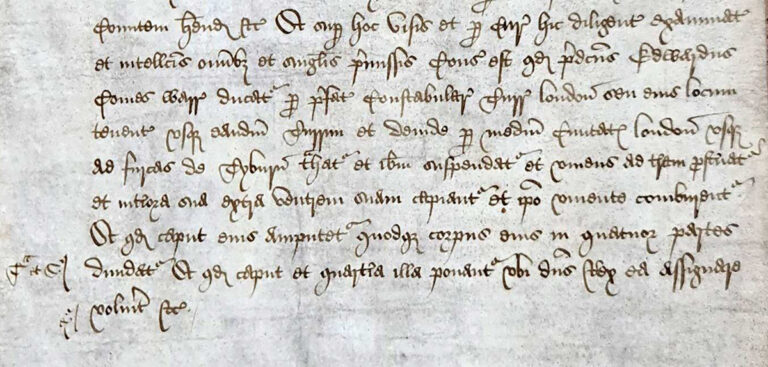
Others, however, record more extensive details. This Exchequer account includes detailed payments made for taking the quartered limbs of a traitor, Henry Talbot, to their intended destinations around the country in 1417. They include a bushel of salt (approximately 30kg) for preserving the limbs, a spear-shaft for fastening Talbot’s head on London bridge, bags and canvas to wrap the limbs in to avoid the stench, and a canvas to cover the carriage so those they passed would not see what was inside.
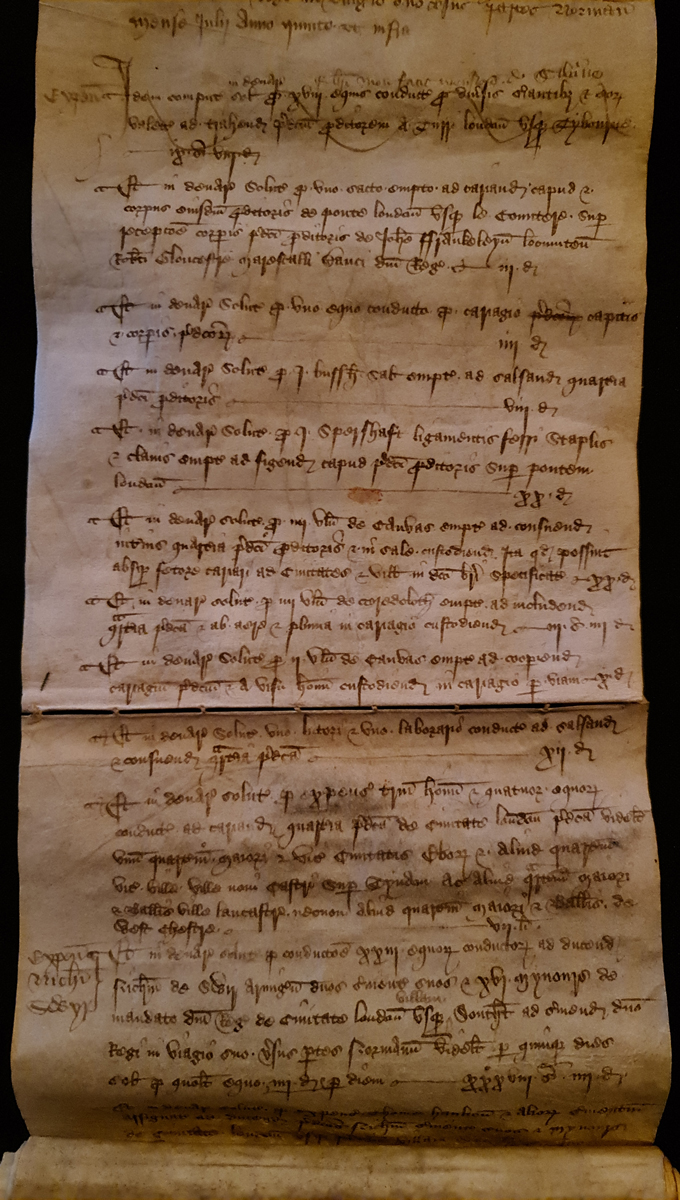
New forms of execution
The symbolism of a treason execution could also take more unusual forms. The execution of Sir John Oldcastle in 1417 linked two separate forms of execution in symbolic fashion once again. Oldcastle was a lollard, a religious reform movement which spread in the early 15th century , and which was the subject of regular crackdowns by the Lancastrian regime. As a religious movement, the lollard movement was faced by charges of both heresy and treason. Oldcastle’s execution combined both charges. For his treason he was drawn to St Giles’ Field, London (the scene of his abortive rising of 1414), where a gallows had already been erected. Suspended by an iron chain, he was then simultaneously hanged and burned (the traditional means of execution for heresy), as ‘a heretic and traitor to God and the king’, thus ‘paying the penalty of both swords’.
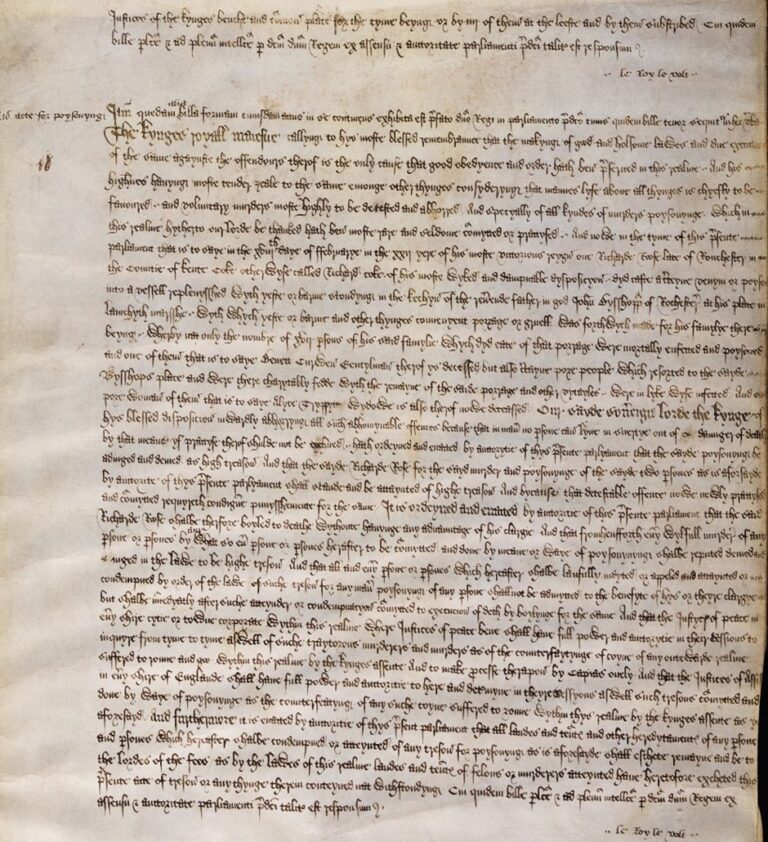
Perhaps the most symbolic and gruesome execution for treason was that of Richard Roose in 1531. Roose had been charged with a new form of treason, attempting to poison the porridge of the Bishop of Rochester, with a new form of execution also introduced in relation to the crime. For poisoning, Roose (and any future poisoners) was to be boiled to death in Smithfield, London, his body placed in a gibbet and symbolically lifted in and out of the water to represent the act of placing the poison in the porridge. This was a visceral, public and horrendous act, intended to act as a powerful disincentive for any would be poisoners.
It would later be repealed by Edward VI (r. 1547–1553) at the start of his reign, along with many other expansions of treason by Henry VIII. You can find out more about Roose and his execution in this thread on our Twitter feed.
Power of the pardon
Violent and symbolic punishments and executions could sometimes be contrasted with displays of royal mercy or mitigation. Noblemen often had their sentence mitigated to beheading, rather than being made to suffer the full horror of the traitor’s death. Anne Boleyn – in probably one of the best known stories of mitigation – had her sentence altered at the request of Henry VIII, from being burned to death to beheading.
More unusual was the last-minute pardon given to a more obscure figure in the 15th century. Thomas Kerver, a gentleman from Reading in Berkshire, was charged with uttering treasonous words against Henry VI in the precinct of Reading Abbey in 1444, stating that it the realm would have been £100,000 wealthier had the king died twenty years earlier when he was young. Kerver’s alleged crimes were investigated twice in order to try and secure a conviction on all counts.
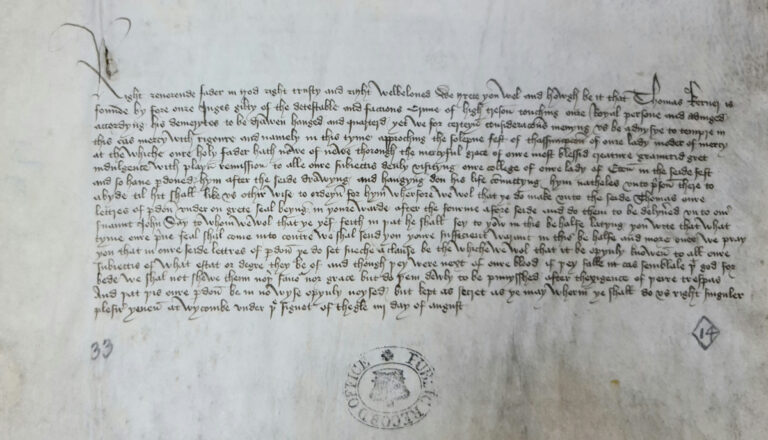
Eventually sentenced to the usual traitor’s death, Kerver faced execution, but was saved by a last-minute pardon by the pious king on account of the fact it was almost the feast of the Assumption, a feast day when those visiting nearby Eton College could receive papal indulgences. He was not, however, entirely free. The letters which authorised Kerver’s pardon stated that he should be drawn through Berkshire to the gallows, hanged until he was nearly dead, and only then told of his pardon. This was a calculated gesture of mercy, allowing the visual warning to those who might consider uttering similar words that would come from seeing the traitor drawn and hanged, while sparing the bloodshed involved.
You can find out more about the stories touched on in this blog in our exhibition Treason: People, Power & Plot, which runs until 6 April 2023, where you can view the following documents and many more:
- The 1352 Treason Act
- The 1531 ‘Act for Poisoning’, which condemned Richard Roose to death
- The trial records of Anne Boleyn
You can also read more in our book, A History of Treason, available to purchase now from our online shop and all good booksellers.
The Museum of London is also currently running an exhibition of the history of executions.
Footnotes
- The Treason Act of 1352, however, makes no mention of the means of executing a traitor, rather it concerns itself with the forfeiture of lands, goods and titles which accompanied the crime of high treason.
I was so surprised to see that there was an “invoice” detailing the cost of transporting Henry Talbot’s limbs, indeed to learn that the task involved payment at all. I’d always assumed/imagined that those working closely for the King, would have slung a body part on the back of their horse and delivered it personally.
I continue to be amazed that such ancient documents as the “invoice” stating the cost of William Wallace’s execution still exists to this day in such superb condition. I had never imagined that there was one. All these years (I am 60) reading one history book after the next and I learn that! I am in awe!
Equally, I could not be,I’ve that there would still exist, indeed had ever existed, such a clear drawing of William de Marisco being drawn to the place of execution.
Thank you so much for all the videos, blogs and material that you have tirelessly put together so that we can learn more about treason, law, plot and execution. I have enjoyed this tremendously and hope to one day soon be able to visit The National Archives in Kew.
The punishment handed out was quite frightening
but now it’s going into the no punishment period
Every time we watch or here the latest news it always about
Shooting children, stabbing People, robbery gang warfare
Drugs Rape and so on ..
And the punishment never seems to match the crime…
I have always understood ‘drawn’ in this sense to mean ‘disembowelled or eviscerated’. (Collin’s English dictionary), which would make more sense.
Hi Ed, in the original Latin the word ‘drawn’ (trahantur) is used to refer to the process of drawing a traitor to the place of execution behind a horse rather than the disembowelling process (which often uses the verb capio instead, as in the example of Edward, earl of Warwick), and it is this drawing behind a horse that is the hallmark of a traitor’s execution. Over the years the terms have often been conflated.